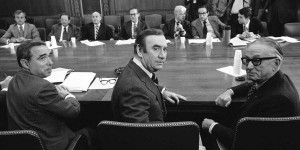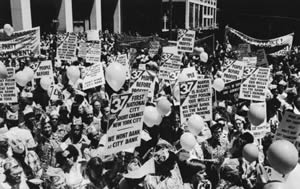By Doug Henwood
Feb. 24, 2012
With the displacement of Greece’s elected government by Eurocrats acting in the interest of the country’s creditors, I thought this would be a good time to reprise the section of my 1997 book Wall Street that covers the New York City fiscal crisis of 1975, which was something of a dress rehearsal for the neoliberal austerity agenda that would go global in the 1980s. Certain celebrity academics are constantly cited for making this argument, but I was there first. You can download Wall Street for free by clicking here: Wall Street.
This chapter, and this book, has mainly been about the private sector, but it would be incomplete to finish a chapter on “governance” without looking at the relations between Wall Street and government, not only in the U.S., but on a world scale.
 One advantage that Wall Street has in public economic debate, aside of course from its immense wealth and power, is that it’s one of the few institutions that look at the economy as a whole. American economic policymaking is, like all the other kinds, largely the result of a clash of interest groups, with every trade association pleading its own special case. Wall Streeters care, or presume to care, about how all the pieces come together into a macroeconomy. The broadest policy techniques—fiscal and monetary policy—are what Wall Street is all about. For some reason, intellectuals like the editors of the New York Review of Books and the Atlantic have decided that investment bankers like Felix Rohatyn and Peter Peterson have thoughts worth reading in essay form. Not surprisingly, both utter a message of austerity—the first with a liberal, and the second with a conservative, spin—hidden behind a rhetoric of economic necessity. These banker–philosophes, creatures of the most overpaid branch of business enterprise, are miraculously presented as disinterested policy analysts.
One advantage that Wall Street has in public economic debate, aside of course from its immense wealth and power, is that it’s one of the few institutions that look at the economy as a whole. American economic policymaking is, like all the other kinds, largely the result of a clash of interest groups, with every trade association pleading its own special case. Wall Streeters care, or presume to care, about how all the pieces come together into a macroeconomy. The broadest policy techniques—fiscal and monetary policy—are what Wall Street is all about. For some reason, intellectuals like the editors of the New York Review of Books and the Atlantic have decided that investment bankers like Felix Rohatyn and Peter Peterson have thoughts worth reading in essay form. Not surprisingly, both utter a message of austerity—the first with a liberal, and the second with a conservative, spin—hidden behind a rhetoric of economic necessity. These banker–philosophes, creatures of the most overpaid branch of business enterprise, are miraculously presented as disinterested policy analysts.
Wall Street’s power becomes especially visible during fiscal crises, domestic and international. On a world scale, the international debt crisis of the 1980s seemed for a while like it might bring down the global financial system, but as it often does, finance was able to turn a crisis to its own advantage.
While easy access to commercial bank loans in the 1970s and early 1980s allowed countries some freedom in designing their economic policies (much of it misused, some of it not), the outbreak of the debt crisis in 1982 changed everything. In the words of Jerome I. Levinson (1992), a former official of the Inter-American Development Bank:
“[To] the U.S. Treasury staff…the debt crisis afforded an unparalleled opportunity to achieve, in the debtor countries, the structural reforms favored by the Reagan administration. The core of these reforms was a commitment on the part of the debtor countries to reduce the role of the public sector as a vehicle for economic and social development and rely more on market forces and private enterprise, domestic and foreign.”
Levinson’s analysis is seconded by Sir William Ryrie (1992), executive vice president of the International Finance Corporation, the World Bank’s private sector arm. “The debt crisis could be seen as a blessing in disguise,” he said, though admittedly the disguise “was a heavy one.” It forced the end to “bankrupt” strategies like import substitution and protectionism, which hoped, by restricting imports, to nurture the development of domestic industries.
 “Much of the private capital that is once again flowing to Latin America is capital invested abroad during the run-up to the debt crisis. As much as 40–50 cents of ever dollar borrowed during the 1970s and early 1980s…may have been invested abroad. This money is now coming back on a significant scale, especially in Mexico and Argentina.”
“Much of the private capital that is once again flowing to Latin America is capital invested abroad during the run-up to the debt crisis. As much as 40–50 cents of ever dollar borrowed during the 1970s and early 1980s…may have been invested abroad. This money is now coming back on a significant scale, especially in Mexico and Argentina.”
In other words, much of the borrowed money was skimmed by ruling elites, parked profitably in the Cayman Islands and Zürich, and Third World governments were left with the bill. When the policy environment changed, some of the money came back home — often to buy newly privatized state assets for a song.
That millions suffered to service these debts seems to matter little to Ryrie. Desperate Southern governments had little choice but to yield to Northern bankers and bureaucrats. Import substitution was dropped, state enterprises were privatized, and borders made porous to foreign investment. After Ryrie’s celebrated capital inflow, Mexico suffered another debt crisis in 1994 and 1995, which was “solved” using U.S. government and IMF guarantees to bail out Wall Street banks and their clients, and creating a deep depression; to make the debts good, Mexicans would have to suffer. Once again, a dire financial/fiscal crisis—the insolvency of an overindebted Mexican government—was used to further a capital-friendly economic agenda.

- Photo credit: AP | New York Gov. Hugh L. Carey, center, flanked by Felix Rohatyn, left, chairman of the New York State Municipal Assistance Corp., and State Comptroller Arthur Levitt, meet with White House officials in Washington, as they seek financial help for New York City. (Nov. 14, 1975)
These fortunate uses of crisis first appeared in their modern form during New York City’s bankruptcy workout of 1975. This is no place to review the whole crisis; let it just be said that suddenly the city found its bankers no longer willing to roll over old debt and extend fresh credits. The city, broke, could not pay. In the name of fiscal rectitude, public services were cut and real fiscal power was turned over to two state agencies, the Municipal Assistance Corp. (MAC, chaired by Rohatyn), and the Emergency Financial Control Board, since made permanent with the Emergency dropped from its name.

DC 37 members joined other city employees in a march on Wall Street. “Jobs and services are a hell of a lot more important than profits,” Victor Gotbaum said at the rally.
Aside from the most routine municipal functions, the city no longer governed itself; a committee of bankers and their delegates did, Rohatyn first among them. Rohatyn, who would later criticize Reaganism for being too harsh, was the director of its dress rehearsal in New York City. Public services were cut, workers laid off, and the physical and social infrastructure left to rot. But the bonds, thank god, were paid, though not without a little melodrama, gimmickry, and delay (Lichten 1986, chap. 6).
The city was admittedly borrowing irresponsibly—though the lenders, it must be said, were lending irresponsibly as well. When a bubble is building, neither side has an incentive to stop its inflation. But when it broke, all the pain of adjustment fell on the citizen–debtors. The pattern would be repeated in the Third World debt crisis, in many U.S. cities over the next 20 years, and, most recently, with the federal budget.
Obviously the bankers have the advantage in a debt crisis; they hold the key to the release of the next post-crisis round of finance. Anyone who wants to borrow again, and that includes nearly everyone, must go along. But that’s not their only advantage. The sources of their power were cited by Jac Friedgut of Citibank (ibid., p. 192):
“We [the banks] had two advantages [over the unions]…. One is that since we were dealing on our home turf in terms of finances, we knew basically what we were talking about, and we knew and had a better idea what it takes to reopen the market or sell this bond or that bond…. The second advantage is that we do have a certain noblesse oblige or tight and firm discipline. So that we could marshal our forces, and when we spoke to the city or the unions we could speak as one voice…. Once a certain basic process has been established that’s an environment in which our intellectual leadership…can be tolerated or recognized…we’re able to get things effected.”
It’s plain from Friedgut’s remarkably candid language that to counter this, one needs expertise, discipline, and the nerve and organization to challenge the “intellectual leadership” of such supremely self-interested parties. According to the union boss Victor Gotbaum (in an interview with Robert Fitch, which Fitch relayed to me), the unions’ main expert at the time, Jack Bigel, didn’t understand the budgetary issues at all, and deferred to Rohatyn, whom he trusted to do the right thing. For the services rendered to municipal labor, the once-Communist Bigel was paid some $750,000 a year, enough to buy himself a posh Fifth Avenue duplex (Zweig 1996). Gotbaum became a close friend of Felix Rohatyn. Politically, the unions were weak, divided, self-protective, unimaginative, and with no political ties to ordinary New Yorkers. It’s easy to see why the bankers won.
What was at stake in New York was no mere bond market concern. In a classic 1976 New York Times op-ed piece, L.D. Solomon, then publisher of New York Affairs, wrote: “Whether or not the promises…of the 1960’s can be rolled back…without violent social upheaval is being tested in New York City…. If New York is able to offer reduced social services without civil disorder, it will prove that it can be done in the most difficult environment in the nation.” Thankfully, Solomon concluded, “the poor have a great capcity for hardship” (quoted in Henwood 1991).
Behind a “fiscal crisis” lurked an entire class agenda, and one that has been quite successfully prosecuted in subsequent crises for the next two decades. But since these are fought on the bankers’ terrain, using their language, they instantly win the political advantage, as nonbankers retreat in confusion, despair, or boredom in the face of all those damned numbers
Doug Henwood edits LBO, a newsletter he founded in 1986, He also hosts Behind the News, a weekly radio show covering economics and politics on KPFA, Berkeley, that is rebroadcast on several other stations across the U.S., and has a worldwide audience via its Internet archive. His book Wall Street is now available for free download here.






